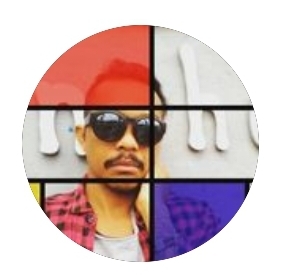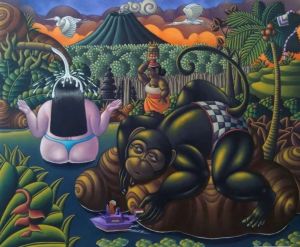- Full Name
- Gede Suanda
- Pen Name
- Gede Sayur
- Photograph by
- @ubudnonmsg
- Link to Photograph
- Website for biography
- Place
- Ubud
- Related Music
- Related Books
- Related Scholars Articles
Biography
In English
Gede ‘Sayur’ Suanda is a multi-talented contemporary Balinese artist who expresses statements about the rapid changes engulfing Bali in both 3-dimensional works as well as paintings. In 2015 Sayur’s landmark installation ‘Last Defence’ was presented in ‘Violent Bali’, a group exhibition by sixty of Bali’s finest contemporary artists at the Tony Raka Gallery in Ubud. The towering 3-metre-high impression of the ‘rook’ chess piece made from bamboo, dried rice stalks and husks was his comment concerning the rapid transformation of rice fields in Bali for modern development. According to the artist, the rice fields are vital to the Balinese way of life, which is constantly under threat and the last defence of the culture, which is increasingly vulnerable to change. More recently, Sayur has channelled his creativity into contemporary paintings. As a child, he learned the technical aspects of Balinese painting passed down through the generations. Drawing is the basic fundamental of Balinese painting and the initial process of rendering the composition details. The application of paint with small hand-crafted bamboo brushes follows various technical, traditional guidelines. The physical action is similar to drawing or colouring in.
The ancient classical Balinese religious paintings that decorate the temples throughout the island function as a collective expression of ideas from the community to the Balinese Gods and ancestors. During the last century, technical aspects of these sacred paintings merged with western painting techniques and individual ideas. As a result, various village styles or “schools” of painting evolved from the 1920s onwards, catering to new tourist markets.
A distinct aspect of traditional Balinese painting is that all visual information is contained within black outlines. When observing these paintings, flowing lines and rhythms entertain our eyes as we traverse the composition from left to right and from the top down. Natural universal rhythms are inseparable from daily life and determine the timing of the many Balinese religious ceremonies and cultural practices. Visual rhythms, therefore, are a unique and essential essence of Balinese painting.
From 1999 – 2006, Sayur studied fine art at the Indonesian Institute of the Arts of Yogyakarta. Living and learning outside the cultural restraints of his village opened him to new ideas, creative influences and time to explore different artistic possibilities. Such an experience is instrumental for the Balinese to help them break free from the rules and collective mindset that define Balinese painting. In doing so, they may create compositions to express personal ideas constructed with modern western painting techniques. Sayur’s time living within a foreign culture allowed him to perceive his upbringing and the ever-changing dynamics of modern Bali through a new lens.
Richard Horstman
@lifeasartasiaIn Balinese
In Indonesian
Examples of work
Harmonic colouration catches the eye. Two white herons on both sides of the smoke create a dynamic sense of movement, emphasising the bird’s motion of flight—our eye dances in tune, one-two-three, observing the icons. As we continue down the composition, the green foliage of the forest captures our attention. The visual rhythm changes again as our eye circumnavigates the leaves. The vertical lines of the tree allow the eye to sweep up and down the elongated trunks. To the right, the artist entertains us with other information, tall palms, curvaceous rice terraces, and round coconuts. He depicts a kite trapped in a tree as a simple, humorous distraction.
The focal point of the composition is the three figures. A Balinese woman carries an offering upon her head. A pale-skinned female tourist with her palms raised and water pouring onto her head participates in a Balinese cleansing ritual called melukat. A monkey upon a brown rock watches on with a grin of delight as he pushes a toy boat into the spring. The swirling curves on the stone are the artist’s modification of a classical icon. The visual rhythms change as the eye flows around the arcs of the figures, each with differing dimensions, colouration and feeling. Finally, we follow the shape of the skimpy blue G-string as it disappears into the tourists behind.







Enable comment auto-refresher